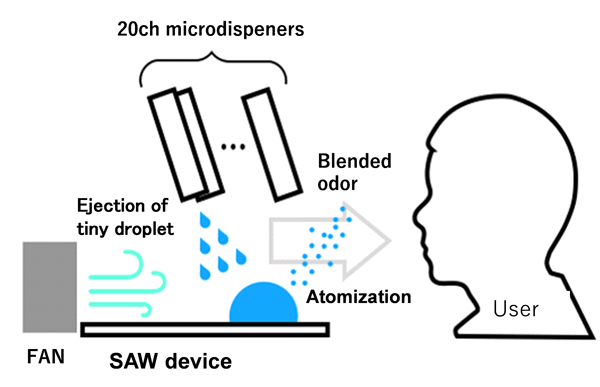
A technology to generate a variety of scents by blending multiple odor components using mass spectra and multidimensional data analysis has been developed by Tokyo Tech researchers. They showed that the scents could be reproduced using a multicomponent olfactory display. Twenty odor components were extracted using the mass spectra of 185 essential oils. The sensory test for seven typical essential oils revealed that their scents could be successfully replicated.
Humans have always been curious; this is the primary driving force of human activities. Among the many endeavors we have undertaken driven by curiosity, recreating the way we experience the world around us in controlled settings have always been a major emphasis. We have recreated almost all senses; what we, we recreated as paintings, photographs, and movies, what we hear, as music, and so on. But the experiences of one sense have always been a challenge to replicate: the sense of smell. This is because unlike the other senses, the factors that let us smell something are more abstract and difficult to recreate exactly.
Various combinations of colors can be produced using three primary colors—red, green, and blue. Although a parallel concept of seven "primary" smells has been proposed before, creating various types of odors using these primary smells has not been achieved so far. A research team from Tokyo Institute of Technology (Tokyo Tech), led by Prof. Takamichi Nakamoto, recently made significant progress in this direction.
Using mass spectrometry, the research team characterized certain essential oils and extracted the corresponding basis vectors using multidimensional data analysis, as depicted in Figure 1. Next, the team created various scents by blending odor components corresponding to these basis vectors. The researchers mimicked a variety of smells simply by adjusting the mixture composition of various odor components. Moreover, an olfactory display was used to generate the scents instantaneously in the gas phase. Their detailed findings are published in IEEJ Transactions on Sensors and Micromachines.

Figure 1. Method of Odor Reproduction
Using mass spectrometry, the researchers characterized certain essential oils and extracted the corresponding basis vectors using multidimensional data analysis. The team then created various scents by blending odor components corresponding to the basis vectors.
Image credit: Takamichi Nakamoto from Tokyo Tech
In all, the researchers measured the mass spectra of 185 essential oils. This was followed by multidimensional data analysis. Accordingly, they extracted 20 basis vectors using the collected mass spectra. Then, they created odor components corresponding to the basis vectors by blending various essential oils.
Accordingly, 20 odor components were set at a multi-component olfactory display. The odor components ejected from microdispensers were blended at the surface of the surface acoustic wave device as shown in Figure 2. This was followed by instantaneous atomization. The user was then instructed to sniff the blended smell. The mixture composition was determined by the drive frequencies of the microdispensers.

Figure 2. How a multicomponent display works
Odor components ejected from microdispensers get blended at the surface of the surface acoustic wave device. This is followed by its instantaneous atomization. After this, the user can sniff the blended smell.
Image credit: Takamichi Nakamoto from Tokyo Tech
The sensory test showed that there was no significant difference between the original and replicated smells in all cases when the seven typical essential oils, namely lemon, palmaloza, carrot seed, elmi, lavender, chypre, and mentha arvensis picked up from 185 essential oils were presented to people using the olfactory display.
According to Dr. Takamichi Nakamoto, "A scent can be reproduced by blending odor components at the olfactory display. There has been no report of odor reproduction using odor components in conjunction with the olfactory display."
Quite astonishingly, it will soon be possible to create scent libraries and preserve the corresponding recipes. In fact, a variety of scents can be instantaneously presented to the user by directing a computer-based command to the olfactory display.
Dr Nakamoto muses, "Olfactory displays linked to a computer could be directed to generate fragrances at movie theatres. We could also program a computer to create special fragrances for people watching animations or playing games. In fact, these machine-generated fragrances can make online shopping, advertising, and digital signage extremely enjoyable. Moreover, scent transmission might be realized since a variety of scents can be generated at remote olfactory display with odor components."
So, the next time you go to watch a movie, don't get surprised if along with the visuals and sounds, you also smell roses when they appear on the screen!

Masaaki Iseki (left) and Professor Takamichi Nakamoto (right)
Comments by Professor Takamichi Nakamoto
This research has a wide range of applications, and we have received many inquiries from the industrial sector after the press release. By creating scent libraries and then generating numerous different scents through instantaneously blending according to computer commands, it is possible to create a variety of digital olfactory contents for use in fields such as entertainment, video games, animation, movies, online shopping, advertising, event production, nursing care, and medical care. Until now, it was difficult to actually handle scents in the IT world, but scientists have successfully developed the fundamental technology for enabling a world of olfactory IT.
This achievement is based on the doctoral dissertation of Masaaki Iseki, who is currently a researcher at Tokyo Tech and a leading author for the Journal of the Institute of Electrical Engineers of Japan. Additionally, researcher Dani Prasetyawan contributed greatly to the work on odor components.
Reference
Authors : |
Masaaki Iseki, Dani Prasetyawan, Yasufumi Yokoshiki, and Takamichi Nakamoto |
Title of original paper : |
A Study of Odor Reproduction Using Multi-component Olfactory Display |
Journal : |
IEEJ Transactions on Sensors and Micromachines |
DOI : |
|
Affiliations : |
Tokyo Institute of Technology, Japan
|
* Corresponding author's email: nakamoto@nt.pi.titech.ac.jp
- *
- This article has been updated to include an image and professor's comments on June 24.
. Any information published on this site will be valid in relation to Science Tokyo.






